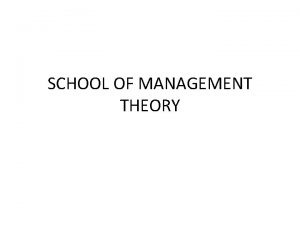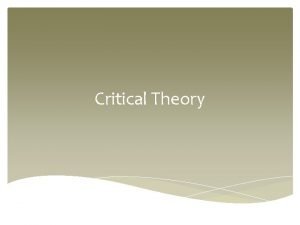Conflict Theory and Schools Conflict Theory Conflict Theory






- Slides: 6

Conflict Theory and Schools Conflict Theory

Conflict Theory • The driving force behind social and educational change in complex societies is the unending struggle between different groups to hold power and status--e. g. males/females, African Americans, European Americans, etc. BUT the basic cause of the conflict goes deeper and it is to be found in the division between classes in a capitalist society. • TWO IMPLICATIONS OF THIS VIEW: (1) people who participate in the struggle see it as racial, ethnic, sexual, etc. , and not as the result of the division between classes. (2) the struggle may not be visible and thus the participants believe that there exist harmony. Conflict Theory 2

Further Implications of the Conflict Model • There is no necessary and direct relation between the intent behind an action or policy and the social effects of that action--by "social effects" the c. t. mean the events whose net result is the continuation of the present system of domination • Because the social effects may arise without conscious intent, there is no need to suggest that the effects are the result of conspiratorial action. • Argument against the Functionalist perspective: functionalists take the interests and perspectives of the dominant social groups in society and--consciously or not --elevate them to the status of universal norms Conflict Theory 3

Marxist Theory • The relationship between the way we think and the way we live: the way people think, perceive, and feel--their "consciousness"--is related to the basic mode of economic production in their society • Conceptual-Ethical-Aesthetic worlds: truth, moral and ethical value they all depend on the concepts that one's culture makes available to them. Conceptual changes may occur in a culture. However, the changes follow changes in the mode of production. • class consciousness: whenever people are related in different ways to the means of production, we have a class society. In such cases people who belong to a class see the world and understand their position in it in a certain way. This constitutes the class consciousness. Conflict Theory 4

Marxist Theory and Schools • Two ways the state serves the ruling class: (i) through the use of repressive powers -- courts, police, army (ii) through developing false consciousness in those who are members of the subordinate class. • Ideological State Apparatuses: mass media, the arts, sports, the church, the family, political parties, trade unions, and above all the schools. They provide people with compelling reasons for doing that which they otherwise might not be inclined to do and which is essential for maintaining the current system of production relations and power. • In a capitalist society schools will serve to reproduce the relations of production that are essential to maintaining the dominance of the capitalist class. But schools do not reproduce the relations of production by (only) reproducing the skills that workers need to be laborers. • While the school in a capitalist system reproduces the relations of production, it also provides people with the belief that they have been given equal chance to succeed (see dominant ideology of meritocracy) – therefore they accept their position in the system. Conflict Theory 5

Schooling – Schooling is a social practice supported and utilized by those in power to maintain their dominance in the social order. – The school is an instrument of class domination serving to reproduce the workforce and maintain class relationships. Conflict Theory 6











